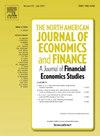Bank liquidity supply and corporate investment during the 2008–2009 financial crisis
IF 3.8
3区 经济学
Q1 BUSINESS, FINANCE
North American Journal of Economics and Finance
Pub Date : 2025-01-01
DOI:10.1016/j.najef.2025.102371
引用次数: 0
Abstract
I use a novel identification strategy to examine whether bank liquidity supply affected corporate investment decisions during the 2008–2009 financial crisis. By exploiting the predetermined variation in the maturity structure of credit lines, I find that firms whose last pre-crisis credit lines were scheduled to mature at the time of the crisis significantly reduced investment relative to similar firms whose pre-crisis credit lines were not scheduled to expire. The results are robust to classifying firms based on the maturity profile of their pre-2006 credit lines and to controlling for the portion of long-term debt coming due in the crisis. Furthermore, this effect is concentrated among financially constrained firms, industries more dependent on external finance, or firms whose pre-crisis lenders were less healthy. Overall, the findings highlight the importance of credit line maturity in explaining investment outcomes during the crisis, consistent with the real effects of bank liquidity supply.
2008-2009年金融危机期间的银行流动性供给与企业投资
我使用一种新的识别策略来检验银行流动性供应是否影响了2008-2009年金融危机期间的企业投资决策。通过利用信贷额度期限结构的预定变化,我发现,相对于危机前信贷额度未计划到期的类似公司,上次危机前信贷额度计划在危机发生时到期的公司显著减少了投资。这些结果对于根据2006年以前信贷额度的期限状况对公司进行分类,以及控制在危机中到期的长期债务的比例,都是可靠的。此外,这种影响主要集中在财务受限的公司、更依赖外部融资的行业,或危机前放贷者健康状况较差的公司。总体而言,研究结果强调了信贷额度期限在解释危机期间投资结果方面的重要性,这与银行流动性供应的实际影响是一致的。
本文章由计算机程序翻译,如有差异,请以英文原文为准。
求助全文
约1分钟内获得全文
求助全文
来源期刊
CiteScore
7.30
自引率
8.30%
发文量
168
期刊介绍:
The focus of the North-American Journal of Economics and Finance is on the economics of integration of goods, services, financial markets, at both regional and global levels with the role of economic policy in that process playing an important role. Both theoretical and empirical papers are welcome. Empirical and policy-related papers that rely on data and the experiences of countries outside North America are also welcome. Papers should offer concrete lessons about the ongoing process of globalization, or policy implications about how governments, domestic or international institutions, can improve the coordination of their activities. Empirical analysis should be capable of replication. Authors of accepted papers will be encouraged to supply data and computer programs.

 求助内容:
求助内容: 应助结果提醒方式:
应助结果提醒方式:


